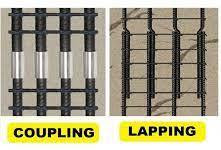Comparison rebar coupler and lapping
Lapping of rebars has long been considered an effective, economical splicing method, but today’s more demanding concrete designs are forcing builders to consider alternatives.
In almost all reinforced-concrete structures, rebars must be spliced. The required length of a bar may be longer than the stock length of steel, or the bar may be too long to be delivered conveniently. In either case, rebar installers end up with two or more pieces of steel that must be spliced together.
Lap splicing, which requires the overlapping of two parallel bars, has long been accepted as an effective, economical splicing method. However, there has been a shift in recent years. Continuing research, more demanding designs in concrete, new materials and the development of composite materials have forced designers to consider alternatives to lap splicing, which is mechanical splices.
Mechanical splices are mechanical connections between two pieces of rebar that enable the bars to behave in a manner similar to continuous lengths of rebar. Mechanical splices join rebar end-to-end, providing many of the advantages of a continuous piece of rebar. They are more reliable than lap splices because they do not depend on concrete for load transfer.
The 5 Key Benefits of Mechanical Splices
1) Improved structural integrity
Mechanical splices maintain load path continuity of the reinforcement, independent of the condition or existence of the concrete. To use splices in tensile regions, they must be able to develop the full strength of the rebar and not create a weak point. Therefore the performance of the system is assured throughout the strain-hardening region where plastic deformations occur. In seismic applications, mechanical splices maintain structural integrity when bars are stressed beyond yield, allowing the predictable formation of plastic hinges.
2) No reliance on concrete for load transfer
In coastal regions, rebar corrosion can produce concrete delamination and spalling. Since lap splices transfer load through the surrounding concrete, when the concrete is gone, the lap splice in effect has failed. Mechanical splices do not rely on the concrete for load transfer and therefore maintain the structural integrity.
3) Elimination of lap splice calculations
Mechanical splicing does away with the tedious calculations needed to determine proper lap lengths and the potential calculation errors.
4) Reduced material costs
Because mechanical splices do not overlap, less rebar is used, reducing some of the material costs. This cost savings can be particularly significant for jobs requiring expensive epoxy- coated or galvanized bars, since building codes require up to 50% longer splice laps for these bars than for standard rebars.
5) Reduced rebar congestion
A common complaint of concrete placing crews is that they can’t get the concrete through the rebar cages. Laps effectively double the steel to concrete ratio, and the resulting congestion can restrict the flow and distribution of larger aggregate particles and limit the effectiveness of vibration. Mechanical splices will significantly reduce this congestion.
Cost Comparison
Although the advantages of mechanical splices are well recognized, a major concern has been their high cost for applications where the codes permit the use of lap splices. But is the perception that mechanical splices cost more than lap splices a reality? By using couplers, contractors can be more cost efficient, able to achieve from 20-50% of cost savings compared to lap splicing. Apart from that, there are many other savings which can be anticipated such as;
Reduction no. of joints
6 meters length will be most ideal for joining and this would result in reduction of no. of laps by,
Assuming height of building: 100 metres
Typical floor height: 3.2 metres
No. of laps: 100 / 3.2 = 31 laps
No. of coupler joints: 100 / 6 = 16 joints
Therefore reduction in no. of laps: [(31-16)/31] x 100% = 48%
Minimal wastages of HTDBs
Assuming floor height of 3.2m and lap length of 1.275m
Length of steel bar per floor is : 3.2m + 1.275m = 4.475m
For a 12metres steel bar, two nos of 4.475metres length bar could be prepared.
Balance: 12metres –4.475metres –4.475metres = 3.05metres
By adopting a 6m bar for coupler joint. No wastage is anticipated. Therefore wastage occurred due to lapping is (3.05m/12m)*100% = 25.42%
Thank You...............😍😍😍



0 Comments